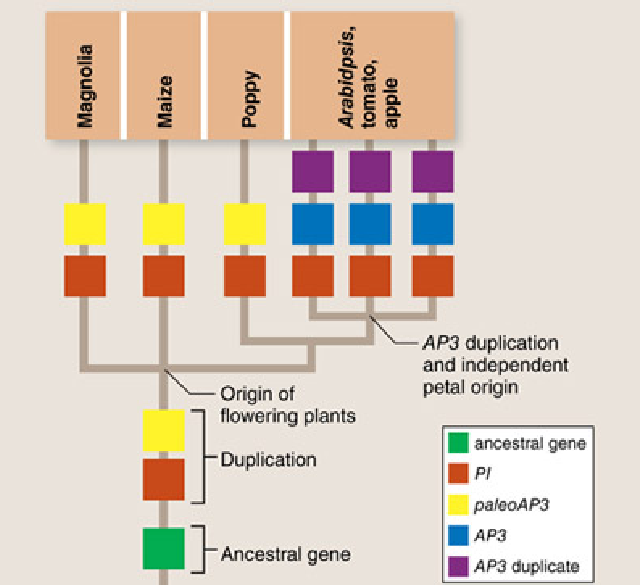Use the figure shown, and what you learned from the text, to choose the true statements about the evolution of flower development. Arabidopsis, tomato, and apple are the eudicots. (choose all that apply)

_____ PI evolved before the most recent common ancestor of all flowering plants.
_____ The eudicots do not have stamens.
_____ PaleoAP3 controls petal development in the eudicots.
_____ With the duplication of paleoAP3, AP3 gained a role in stamen development.
_____ AP3 with a role in petal development is a shared derived character of eudicots.
Clarify Question
· What is the key concept addressed by the question?
· What type of thinking is required?
· What key words does the question contain and what do they mean?
Gather Content
· What do you already know about the evolution of flower development genes?
Consider Possibilities
· Consider the different answer options. Which can you rule out?
Choose Answer
· Given what you now know, what information and/or problem solving approach is most likely to produce the correct answer?
Reflect on Process
· Did your problem-solving process lead you to the correct answer? If not, where did the process break down or lead you astray? How can you revise your approach to produce a more desirable result?
__X__ PI evolved before the most recent common ancestor of all flowering plants.
_____ The eudicots do not have stamens.
_____ PaleoAP3 controls petal development in the eudicots.
_____ With the duplication of paleoAP3, AP3 gained a role in stamen development.
__X__ AP3 with a role in petal development is a shared derived character of eudicots.
Clarify Question
· What is the key concept addressed by the question?
o This question addresses the evolution of flower development genes.
· What type of thinking is required?
o This question is asking you to analyze the information given, using logic, to dissect the problem and determine the answer.
· What key words does the question contain and what do they mean?
o Eudicots are a large clade of flowering plants.
Gather Content
· What do you already know about the evolution of flower development genes?
o The flower development gene AP3 evolved its function by a series of two gene duplication and divergence events.
o A gene duplication can facilitate evolution because it provides a backup gene that can mutate without being lethal to the organism.
o In eudicots, AP3 retains its role in stamen development, and has a new role in petal formation as well. AP3 mutant plants do not produce either petals or stamens.
Consider Possibilities
· Consider the different answer options. Which can you rule out?
o Is it true that the eudicots do not have stamens? (i.e., lack stamens?) No. All the flowering plants have stamens. Mutants may lack stamens, but that is not the normal condition.
o Is it true that paleoAP3 controls petal development in the eudicots? No. You can see in the diagram that the yellow box representing paleoAP3 duplicated and diverged into two “new” genes called AP3 and AP3 duplicate. The gene AP3 acquired a new function controlling petal development in the eudicots.
o Is it true that with the duplication of paleoAP3, AP3 gained a role in stamen development? No, that was one of the ancestral functions, as we learned from the text.
Choose Answer
· Given what you now know, what information and/or problem solving approach is most likely to produce the correct answer?
o Is it true that AP3‘s role in petal development is a shared derived character of eudicots? Yes. The AP3 gene (blue boxes), and its role in petal development, evolved early in the eudicot lineage.
o Is it true that PI evolved before the most recent common ancestor of all flowering plants? Yes. You can see in the diagram that the green box duplicated into the yellow box and the red box representing the PI gene, before the split of the groups of flowering plants.
Reflect on Process
· Did your problem-solving process lead you to the correct answer? If not, where did the process break down or lead you astray? How can you revise your approach to produce a more desirable result?
o This question asked you to choose true statements about the evolution of flower development.
o The question required you to analyze the information given, using logic, to dissect the problem and determine the answer.
o Did you recognize that the evolution of the AP3 gene involved two gene duplication events, and changes in functional roles?
You might also like to view...
Which of these structures does not begin development during embryogenesis?
A. apical meristem B. vascular tissue C. floral primordia D. leaf primordial E. ground tissue
Which of the following statements is false?
a. Lizards are a very small component of the present-day reptiles. b. Lizards gave rise to the snakes. c. Some lizards are not predators. d. Lizards have over lapping scales on their bodies. e. All lizards are roughly the same size
All of the following are prion diseases EXCEPT
a. BSE. b. Kuru. c. Mad Cow Disease. d. variant Creutzfeldt-Jacob disease. e. all of these are prion diseases.
Which statement about the sense of smell in humans is most accurate?
A) Combinations of over 300 receptors allow us to discern thousands of scents. B) Smell is about equally as strong as taste. C) Ciliated cells rapidly move scent molecules to the brain for rapid analysis. D) One hundred different receptor varieties allow us to discern about 100 scents.